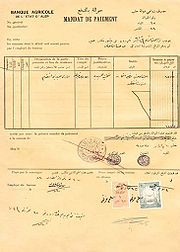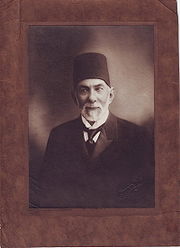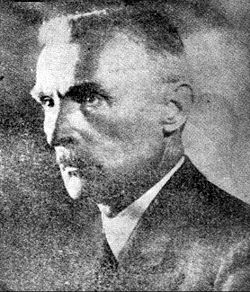
State of Aleppo
Encyclopedia
The State of Aleppo was one of the five states that were established by the French
High Commissioner in Syria and Lebanon General Henri Gouraud in the French Mandate of Syria
which followed the San Remo conference
and the collapse of King Faisal I's short-lived monarchy in Syria.
The other states were the State of Damascus
(1920), the State of Alawites (1920) and the State of Jabal Druze (1921). The State of Greater Lebanon (1920) became later the modern country of Lebanon
. The capital of the State of Aleppo was Aleppo
.
 The State of Aleppo was declared by the French General Henri Gouraud on 1 September 1920 as part of a French scheme to make Syria easier to control by dividing it into several smaller states. France became more hostile to the idea of a united Syria after the Battle of Maysaloun. The State of Aleppo included the Sanjak of Alexanderetta and was governed by Kamil Pasha al-Qudsi.
The State of Aleppo was declared by the French General Henri Gouraud on 1 September 1920 as part of a French scheme to make Syria easier to control by dividing it into several smaller states. France became more hostile to the idea of a united Syria after the Battle of Maysaloun. The State of Aleppo included the Sanjak of Alexanderetta and was governed by Kamil Pasha al-Qudsi.
By separating Aleppo from Damascus, Gouraud wanted to capitalize on a traditional state of competition between the two cities and turn it into political division. The people in Aleppo were unhappy with the fact that Damascus was chosen as capital for the new nation of Syria. Gouraud sensed this sentiment and tried to manipulate it by making Aleppo the capital of a large and wealthier state with which it would have been hard for Damascus to compete. The State of Aleppo as drawn by France contained most of the fertile area of Syria—namely it contained the fertile country of Aleppo in addition to the entire fertile basin of river Euphrates
. The state also had access to sea via the autonomous Sanjak of Alexandretta. On the other hand, Damascus, which is basically an oasis on the fringes of the Syrian Desert
, had neither enough fertile land nor access to sea. Basically, Gouraud wanted to lure Aleppo by giving it control over most of the agricultural and mineral wealth of Syria so that it would never want to unite with Damascus again.
period, most notably Circassians, Adyghe
, Albanians
, Bosnians
, Bulgars
, Turks
, Kabardins, Chechens, and others). Significant Shiite populations lived in Aleppo too, in towns such as Nebbol, Fu'a, Az Zahra', Kefrayya, and M'art Misrin. While the Alawites concentrated particularly in the autonomous Sanjak of Alexandretta.
Aleppo was also a home to one of the richest and most diversified Christian
communities of the Orient
. Christians belonging to a dozen different congregations (with prevalence of the Armenian
and Syriac Orthodox Church and other Orthodox
denominations) represented about a third of the population of Aleppo city, making it the city with the largest Christian community in the Middle East
outside Lebanon
. Many Christians inhabited the eastern districts of the state too, mainly Syriac and Assyrian
Christians.
In 1923, the total population of the state was around 604,000 (excluding the nomadic population of the eastern regions).
Aleppo city had also a large Jewish community of about 10,000 people.

(Interior), Subhi Bey Al Nayyal (Justice), Nasri Effendi Bakhash (Commerce and Agriculture) and Victor Effendi 'Ajouri (Finance). On Al Mallah's resignation in 1921, he was succeeded by Al Nayyal as Director of the Interior and Zaki Bey Al Gorani was selected to succeed Al Nayyal as Director of Justice. In 1923 the Council of Directors was abolished following the establishment of the Syrian Federation.
.
 Ibrahim Hanano was a native of Aleppo and a prominent member of the Syrian National Congress
Ibrahim Hanano was a native of Aleppo and a prominent member of the Syrian National Congress
which was elected in 1919, and which refused the French mandate of Syria. Supported by the Turkish nationalist leader Mustafa Kemal Atatürk
, Hanano started an armed insurgency against the French that lasted until he was arrested in 1921. Hanano was tried in the same year in an Aleppo court, but he was found not guilty by the judges by three votes to two; probably the verdict was influenced by the crowds of supporters who gathered around the courthouse in that day.
Hanano moved to political opposition afterwards, and in 1926, he played a major role in preventing the secession of Aleppo from the State of Syria established in December 1924. He died in 1935.
on 1 December 1924. With the centralization of the new Syrian state in 1925, Aleppo lost its autonomy and restored its provincial status. The incumbent governor general of the state of Aleppo Mar'i Pasha Al Mallah
was named governor (vali) of the province of Aleppo (with a rank of minister). However, the colonial flag of the State of Aleppo remained in use until 25 January 1925 when it was finally abolished.
France
The French Republic , The French Republic , The French Republic , (commonly known as France , is a unitary semi-presidential republic in Western Europe with several overseas territories and islands located on other continents and in the Indian, Pacific, and Atlantic oceans. Metropolitan France...
High Commissioner in Syria and Lebanon General Henri Gouraud in the French Mandate of Syria
French Mandate of Syria
Officially the French Mandate for Syria and the Lebanon was a League of Nations mandate founded after the First World War and the partitioning of the Ottoman Empire...
which followed the San Remo conference
San Remo conference
The San Remo Conference was an international meeting of the post-World War I Allied Supreme Council, held in Sanremo, Italy, from 19 to 26 April 1920. It was attended by the four Principal Allied Powers of World War I who were represented by the prime ministers of Britain , France and Italy and...
and the collapse of King Faisal I's short-lived monarchy in Syria.
The other states were the State of Damascus
State of Damascus
The State of Damascus was one of the six states established by the French General Henri Gouraud in the French Mandate of Syria which followed the San Remo conference and the defeat of King Faisal's short-lived monarchy in Syria....
(1920), the State of Alawites (1920) and the State of Jabal Druze (1921). The State of Greater Lebanon (1920) became later the modern country of Lebanon
Lebanon
Lebanon , officially the Republic of LebanonRepublic of Lebanon is the most common term used by Lebanese government agencies. The term Lebanese Republic, a literal translation of the official Arabic and French names that is not used in today's world. Arabic is the most common language spoken among...
. The capital of the State of Aleppo was Aleppo
Aleppo
Aleppo is the largest city in Syria and the capital of Aleppo Governorate, the most populous Syrian governorate. With an official population of 2,301,570 , expanding to over 2.5 million in the metropolitan area, it is also one of the largest cities in the Levant...
.
Establishment

By separating Aleppo from Damascus, Gouraud wanted to capitalize on a traditional state of competition between the two cities and turn it into political division. The people in Aleppo were unhappy with the fact that Damascus was chosen as capital for the new nation of Syria. Gouraud sensed this sentiment and tried to manipulate it by making Aleppo the capital of a large and wealthier state with which it would have been hard for Damascus to compete. The State of Aleppo as drawn by France contained most of the fertile area of Syria—namely it contained the fertile country of Aleppo in addition to the entire fertile basin of river Euphrates
Euphrates
The Euphrates is the longest and one of the most historically important rivers of Western Asia. Together with the Tigris, it is one of the two defining rivers of Mesopotamia...
. The state also had access to sea via the autonomous Sanjak of Alexandretta. On the other hand, Damascus, which is basically an oasis on the fringes of the Syrian Desert
Syrian Desert
The Syrian Desert , also known as the Syro-Arabian desert is a combination of steppe and true desert that is located in the northern Arabian Peninsula covering 200,000 square miles . also the desert is very rocky and flat...
, had neither enough fertile land nor access to sea. Basically, Gouraud wanted to lure Aleppo by giving it control over most of the agricultural and mineral wealth of Syria so that it would never want to unite with Damascus again.
Population
The majority in the Aleppo state were Sunni Muslims, they were mainly Arabs but also Kurds, especially in the eastern regions, and other diverse ethnicities relocated during the OttomanOttoman Empire
The Ottoman EmpireIt was usually referred to as the "Ottoman Empire", the "Turkish Empire", the "Ottoman Caliphate" or more commonly "Turkey" by its contemporaries...
period, most notably Circassians, Adyghe
Adyghe
The Adyghe or Adygs , also often known as Circassians or Cherkess, are in origin a North Caucasian ethnic groupwho were displaced in the course of the Russian conquest of the Caucasus in the 19th century, especially after the Russian–Circassian War of 1862.Adyghe people mostly speak Adyghe and most...
, Albanians
Albanians
Albanians are a nation and ethnic group native to Albania and neighbouring countries. They speak the Albanian language. More than half of all Albanians live in Albania and Kosovo...
, Bosnians
Bosnians
Bosnians are people who reside in, or come from, Bosnia and Herzegovina. By the modern state definition a Bosnian can be anyone who holds citizenship of the state. This includes, but is not limited to, members of the constituent ethnic groups of Bosnia and Herzegovina: Bosniaks, Bosnian Serbs and...
, Bulgars
Bulgars
The Bulgars were a semi-nomadic who flourished in the Pontic Steppe and the Volga basin in the 7th century.The Bulgars emerge after the collapse of the Hunnic Empire in the 5th century....
, Turks
Turkish people
Turkish people, also known as the "Turks" , are an ethnic group primarily living in Turkey and in the former lands of the Ottoman Empire where Turkish minorities had been established in Bulgaria, Cyprus, Bosnia and Herzegovina, Georgia, Greece, Kosovo, Macedonia, and Romania...
, Kabardins, Chechens, and others). Significant Shiite populations lived in Aleppo too, in towns such as Nebbol, Fu'a, Az Zahra', Kefrayya, and M'art Misrin. While the Alawites concentrated particularly in the autonomous Sanjak of Alexandretta.
Aleppo was also a home to one of the richest and most diversified Christian
Christian
A Christian is a person who adheres to Christianity, an Abrahamic, monotheistic religion based on the life and teachings of Jesus of Nazareth as recorded in the Canonical gospels and the letters of the New Testament...
communities of the Orient
Orient
The Orient means "the East." It is a traditional designation for anything that belongs to the Eastern world or the Far East, in relation to Europe. In English it is a metonym that means various parts of Asia.- Derivation :...
. Christians belonging to a dozen different congregations (with prevalence of the Armenian
Armenian Apostolic Church
The Armenian Apostolic Church is the world's oldest National Church, is part of Oriental Orthodoxy, and is one of the most ancient Christian communities. Armenia was the first country to adopt Christianity as its official religion in 301 AD, in establishing this church...
and Syriac Orthodox Church and other Orthodox
Orthodox Christianity
The term Orthodox Christianity may refer to:* the Eastern Orthodox Church and its various geographical subdivisions...
denominations) represented about a third of the population of Aleppo city, making it the city with the largest Christian community in the Middle East
Middle East
The Middle East is a region that encompasses Western Asia and Northern Africa. It is often used as a synonym for Near East, in opposition to Far East...
outside Lebanon
Lebanon
Lebanon , officially the Republic of LebanonRepublic of Lebanon is the most common term used by Lebanese government agencies. The term Lebanese Republic, a literal translation of the official Arabic and French names that is not used in today's world. Arabic is the most common language spoken among...
. Many Christians inhabited the eastern districts of the state too, mainly Syriac and Assyrian
Assyrian people
The Assyrian people are a distinct ethnic group whose origins lie in ancient Mesopotamia...
Christians.
In 1923, the total population of the state was around 604,000 (excluding the nomadic population of the eastern regions).
Aleppo city had also a large Jewish community of about 10,000 people.
Governors

- 1920–1922 General Kamil Pasha al-Qudsi (1845–1926)
- 1923 Mustafa Bey Barmada (1883–1953)
- 1924–1925 Mar'i Pasha Al MallahMar'i Pasha Al MallahMar'i Pasha Al Mallah : Syrian political leader and Statesman. Born in Aleppo . Graduated from the Galatasaray Mekteb-i Sultanisi , Constantinople, 1876...
(1856–1930)
French Delegates
- 1920–1922 General de Lamothe
- 1922–1924 General Billotte (1875–1940)
- 1925 Monsieur Jacques Reclus
The Council of Directors
A Council of Directors was created in 1920 to complement the governor general. The four members of the Council were: Mar'i Pasha Al MallahMar'i Pasha Al Mallah
Mar'i Pasha Al Mallah : Syrian political leader and Statesman. Born in Aleppo . Graduated from the Galatasaray Mekteb-i Sultanisi , Constantinople, 1876...
(Interior), Subhi Bey Al Nayyal (Justice), Nasri Effendi Bakhash (Commerce and Agriculture) and Victor Effendi 'Ajouri (Finance). On Al Mallah's resignation in 1921, he was succeeded by Al Nayyal as Director of the Interior and Zaki Bey Al Gorani was selected to succeed Al Nayyal as Director of Justice. In 1923 the Council of Directors was abolished following the establishment of the Syrian Federation.
The Representative Council
The legislature was the Representative Council, and the majority of its members were pro-French. Some of the prominent deputies were Subhi Bey Barakat who later served as President of the Syrian Federation, Aleppo's mayor Ghaleb Bey Ibrahim Pasha, the head of the Chamber of Commerce Salim Janbarat, the lawyer Michel Janadri and Fakhir Al Jabiri, elder brother of nationalist leader Saadallah al-JabiriSaadallah al-Jabiri
Saadallah al-Jabiri , is a Syrian politician and a two-time prime minister of Syria. He was born in Aleppo, and became the leader of the National Bloc during the French mandate era. He also served as foreign minister in a number of cabinets....
.
The Revolt of Hanano

Syrian National Congress
The Syrian National Congress was convened in July 1919 in Damascus, Syria to prepare for the King-Crane Commission of inquiry on the future of Greater Syria after the fall of the Ottoman Empire. The congress was attended by representative from all parts of Syria. The participants showed...
which was elected in 1919, and which refused the French mandate of Syria. Supported by the Turkish nationalist leader Mustafa Kemal Atatürk
Mustafa Kemal Atatürk
Mustafa Kemal Atatürk was an Ottoman and Turkish army officer, revolutionary statesman, writer, and the first President of Turkey. He is credited with being the founder of the Republic of Turkey....
, Hanano started an armed insurgency against the French that lasted until he was arrested in 1921. Hanano was tried in the same year in an Aleppo court, but he was found not guilty by the judges by three votes to two; probably the verdict was influenced by the crowds of supporters who gathered around the courthouse in that day.
Hanano moved to political opposition afterwards, and in 1926, he played a major role in preventing the secession of Aleppo from the State of Syria established in December 1924. He died in 1935.
The Syrian Federation and the State of Syria
On 22 June 1922, General Gouraud announced the Syrian Federation (la Fédération Syrienne) or what was then-called Union of Syrian States. The federation included the states of Damascus, Aleppo, and the Alawite State. In 1924, the Alawite State was separated again. The Syrian Federation was incorporated into the State of SyriaSyria
Syria , officially the Syrian Arab Republic , is a country in Western Asia, bordering Lebanon and the Mediterranean Sea to the West, Turkey to the north, Iraq to the east, Jordan to the south, and Israel to the southwest....
on 1 December 1924. With the centralization of the new Syrian state in 1925, Aleppo lost its autonomy and restored its provincial status. The incumbent governor general of the state of Aleppo Mar'i Pasha Al Mallah
Mar'i Pasha Al Mallah
Mar'i Pasha Al Mallah : Syrian political leader and Statesman. Born in Aleppo . Graduated from the Galatasaray Mekteb-i Sultanisi , Constantinople, 1876...
was named governor (vali) of the province of Aleppo (with a rank of minister). However, the colonial flag of the State of Aleppo remained in use until 25 January 1925 when it was finally abolished.
See also
- French Mandate of SyriaFrench Mandate of SyriaOfficially the French Mandate for Syria and the Lebanon was a League of Nations mandate founded after the First World War and the partitioning of the Ottoman Empire...
- State of Alawites
- Jabal el Druze (state)Jabal el Druze (state)Jabal al-Druze was an autonomous state in the French Mandate of Syria from 1921 to 1936, designed to function as a government for the local Druze population under French oversight.-Nomenclature:...
- Alexandretta/HatayHatay ProvinceHatay Province is a province in southern Turkey, on the Mediterranean coast. It is bordered by Syria to the south and east and the Turkish provinces of Adana and Osmaniye to the north. The province is part of Çukurova, a geographical, economical and cultural region that covers the provinces of...
- State of DamascusState of DamascusThe State of Damascus was one of the six states established by the French General Henri Gouraud in the French Mandate of Syria which followed the San Remo conference and the defeat of King Faisal's short-lived monarchy in Syria....
- List of French possessions and colonies
- French colonial empireFrench colonial empireThe French colonial empire was the set of territories outside Europe that were under French rule primarily from the 17th century to the late 1960s. In the 19th and 20th centuries, the colonial empire of France was the second-largest in the world behind the British Empire. The French colonial empire...
- French colonial flagsFrench colonial flagsSome of the colonies, protectorates and mandates of the French Colonial Empire used distinctive colonial flags. These most commonly had a French Tricolour in the canton....

